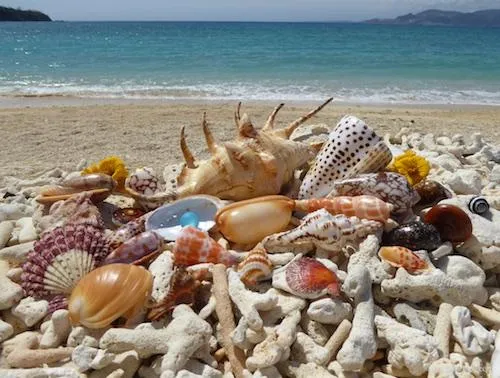Most Recent Blogs

Cone Shells: Pretty, but Potentially Deadly
“By respecting the laws and the delicate balance of marine ecosystems, we can ensure that Thailand's seas remain vibrant and thriving for generations to come. Let's join forces to protect and preserve the beauty of our oceans, one shell at a time.”
- Misty Dowling
Unveiling the Mysteries of Cone Shells:
At Baan Suay Bantai, we're committed to not only providing unforgettable experiences but also ensuring the safety and well-being of our guests, and promoting conservation efforts and responsible tourism practices to preserve Thailand’s natural beauty and wildlife. In this blog, we'll explore the fascinating world of cone shells, from their global distribution to their cultural significance, and everything in between.
🐚 Cone Shells: Nature's Beauty with a Sting
Ah, the allure of the seashore! The sand between your toes, the salty breeze caressing your skin, and the treasure trove of shells scattered along the shore. It's tempting, isn't it? To reach down and scoop up those beautiful cone shells, each one a masterpiece of nature's design. But before you make that grab, let's have a little chat about these seemingly innocent treasures.
Cone Shells: Pretty, but Potentially Deadly
Cone shells, with their exquisite patterns and vibrant hues, may seem like harmless treasures waiting to be plucked from the sand. But don't be fooled by their enchanting appearance – these seemingly innocuous shells harbor a deadly secret.
Cone shells, belonging to the Conidae family, are ubiquitous inhabitants of tropical waters worldwide. Found in regions spanning the Indo-Pacific, Atlantic, and Indian Oceans, as well as the Mediterranean Sea, these remarkable creatures thrive in a variety of marine environments. From the vibrant coral reefs of the Great Barrier Reef to the rocky shores of the Caribbean, cone shells can be found in every corner of the globe, contributing to the rich tapestry of marine life. And yes, that means also in Thailand!
Cultural Significance: Tales from the Sea
Throughout history, cone shells have held a special place in the hearts and minds of coastal communities around the world. In some cultures, these shells are revered as symbols of protection or good fortune, while in others, they feature prominently in folklore and mythology. For example, in Polynesian culture, cone shells are believed to possess mystical powers and are used in traditional ceremonies and rituals. Similarly, in Indigenous Australian folklore, cone shells are associated with stories of creation and the dreamtime.
The Deadly Sting of Cone Shells
Cone shells are not your average seashells; they're home to venomous snails capable of delivering a potent sting. Imagine this: you're wandering along the shore, admiring the array of shells scattered along the sand, when you spot a striking cone shell. Without a second thought, you reach down to pick it up – and that's when disaster strikes.
The venomous inhabitants of cone shells are not to be trifled with. Their harpoon-like appendages, armed with powerful toxins, can deliver a sting that is not only excruciatingly painful but potentially deadly. In fact, cone shell stings have been known to cause paralysis, respiratory failure, and even death in severe cases.
Behavioral Patterns: The Art of Predation
Cone shells are masterful predators, employing a variety of tactics to capture their prey. During the day, these snails conceal themselves in the sand or among rocks, awaiting the cover of darkness to emerge and hunt. Using their venomous harpoons, they inject potent toxins into their unsuspecting victims, paralyzing them instantly. This stealthy approach allows cone shells to target a wide range of prey, including fish, mollusks, and even other cone shells.
Know Thy Enemy: Identifying Dangerous Species
Identifying dangerous cone shell species can be challenging, as they come in a variety of patterns and colors. Among the most notorious cone shells are species such as Conus textile, Conus aulicus, Conus striatus, and Conus geographus. These stealthy predators employ a variety of toxins to incapacitate their prey, making them formidable adversaries for any unsuspecting beachcomber.

Conus textile
Size: Up to 10cm

Conus aulicus
Size: Up to 16cm
Dangerous: Yes

Conus striatus
Size: 12cm
Dangerous: Very

Conus geographus
Size: Up to 16cm
Dangerous: Extremly
Treatment
If you do find yourself in the event (where you ignored this warning) of a cone shell stung, prompt medical attention is crucial. While there is currently no specific antivenom for cone shell envenomation, you should still head to a hospital immediately.
⚠️ In the mean time:
Immerse the affected area in water as hot as tolerable (not over 60c)
Immobilise the limb
Pressure bandage
Try to stay calm
The people around will have to keep a close eye on you and be ready to give CPR and rescue breaths, that is if they’re willing to battle through the fluids projecting. Once you’ve made it hospital then you should be fine under professional medical care, unless it was a geography cone shell that nailed you, if so you have only a 30% chance of survival. (resource: Local Dive Thailand)
Unlocking Nature's Secrets: Scientific Potential
On the positive side and despite their deadly reputation, cone shells hold immense scientific value. Researchers are fascinated by the complex toxins found in cone shell venom, which could hold the key to developing new medical treatments, including targeted cancer therapies and potent painkillers. By studying cone shells and their venom, scientists hope to unlock the secrets of nature and harness its potential for the benefit of humanity.
The Legal Ramifications of Shell Collecting
But the dangers of cone shells extend beyond their venomous inhabitants – there are also legal implications to consider. In Thailand, it is strictly prohibited to remove shells or coral from the beach, dead or alive. Violators may face hefty fines or even imprisonment for disrupting the delicate balance of marine ecosystems.
Conservation Efforts: Protecting Paradise
In light of the declining coral populations and increasing threats to marine ecosystems, conservation efforts are more critical than ever. Organizations such as the Oceans For All Foundation work tirelessly to raise awareness about the importance of preserving cone shells and their habitats. By supporting these initiatives and practicing responsible tourism, we can not only ensure our safety but also ensure that future generations can continue to enjoy the wonders of the ocean.
A Call to Action: Protecting Thailand's Seas
So, what can we do to protect ourselves and the marine life that calls Thailand's seas home?
Admire, Don't Collect - As visitors to the shores of Koh Samui, it's essential that we practice responsible tourism and respect the delicate balance of marine ecosystems. Avoid touching or collecting shells and coral, as doing so can disrupt fragile habitats and harm marine life. Instead, take time to admire the beauty of nature from a respectful distance and leave only footprints behind.
By respecting the laws and the delicate balance of marine ecosystems, we can ensure that Thailand's seas remain vibrant and thriving for generations to come. Let's join forces to protect and preserve the beauty of our oceans, one shell at a time.
© 2023+ Misty Dowling Media - All Rights Reserved

